Disclosure: Meeple Mountain received a free copy of this product in exchange for an honest, unbiased review. This review is not intended to be an endorsement.
Meadow is one of my favourite games of 2021, full of tight mechanics that tell surprisingly powerful narratives about how organisms interact and food webs are constructed. It’s an incredibly relaxing game that can somehow also take up all available space in your brain. If you aren’t familiar with it, check out my review here.
As someone who likes board game expansions, I was excited when Meadow: Downstream was announced and then slightly hesitant when I learned just what it involved – how would all the new stuff impact the gorgeously balanced ecosystem of the base game?
Is this an expansion worth canoe-dling with or is it simply oar-ful? Let’s find out!
A River Runs Through It
Expansions come in many types, from those that slot into an existing system with barely a ripple to those that are an extra tributary joining the main flow. Downstream splashes into that second camp: the core essence of Meadow remains the same, but now there’s an additional board and type of card trickling off the edge.
The river board joins the campfire and main boards in the centre of the table, turning table space into a precious resource. A river winds down the new board to a small market of river cards and each player gains a happy kayaker piece.

Not a lot about the basic experience changes – you’ll still use your path tokens to claim cards that you can then play into your meadow area, provided you have the right symbols showing on existing cards. The river cards can only be accessed with the original “?” path token and a new action river trail token. Every round you’ll claim at least 1 river card.
Unlike the meadow cards, river cards don’t score you points directly. Instead, they propel your kayaker down the river, encountering spaces that give you bonuses, extra actions and, yes, points as you travel along.
Bifurcation or Confluence?
It’s a weird one, Downstream. Since almost all the new cards and their associated kayaker mechanism are restricted to the river board, it feels, at first, very separate from the original game. This feeling is compounded by the fact that, fittingly, you don’t have to work very hard to drift along the river. Having that extra action token restricted to just the river board means you naturally just float a little way with the current. It feels like you’re playing Meadow but getting a little something extra for free.
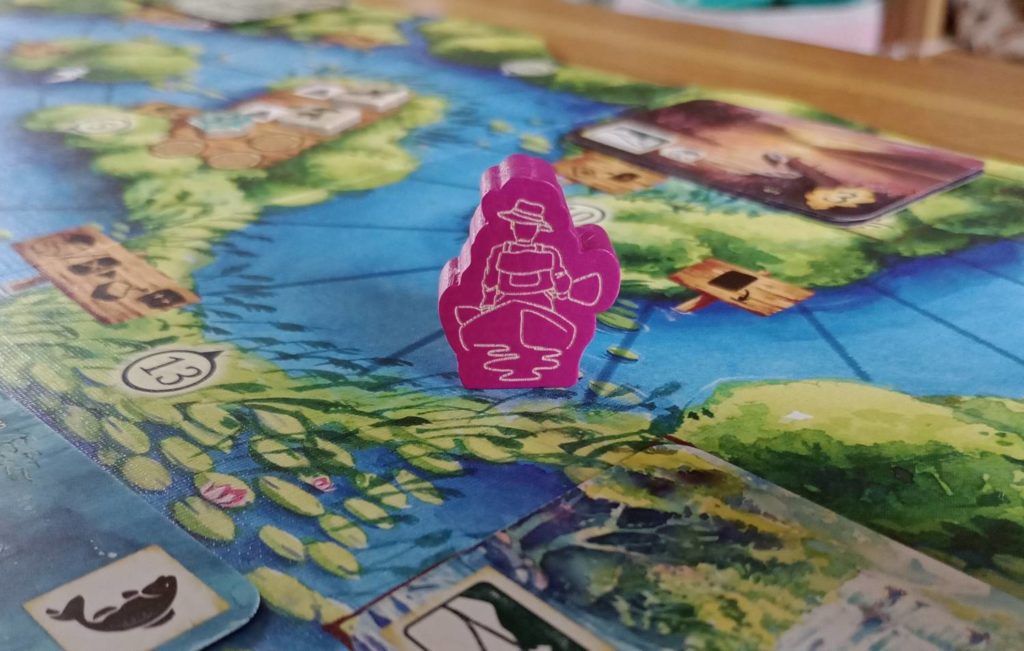
To get to the best bonuses and higher points you’ll need to paddle a bit harder, but in many ways you could just ignore much of what Downstream offers and focus on the original meadow card combinations. It could be seen as disconnected if you aren’t truly engaging with it.
Except… just as everything revealed itself to be interconnected in the original game, the Downstream additions are fundamentally intertwined with their dry-land host.
Those new river cards might reward you by speeding your boat along the river, but their various symbols – fish, water ground and weird triangles aside – are the same as those found on the meadow cards. Whilst the oars and river track may distract at first, as you play you discover that the river market can be just as useful as the original, and just as restrictive.
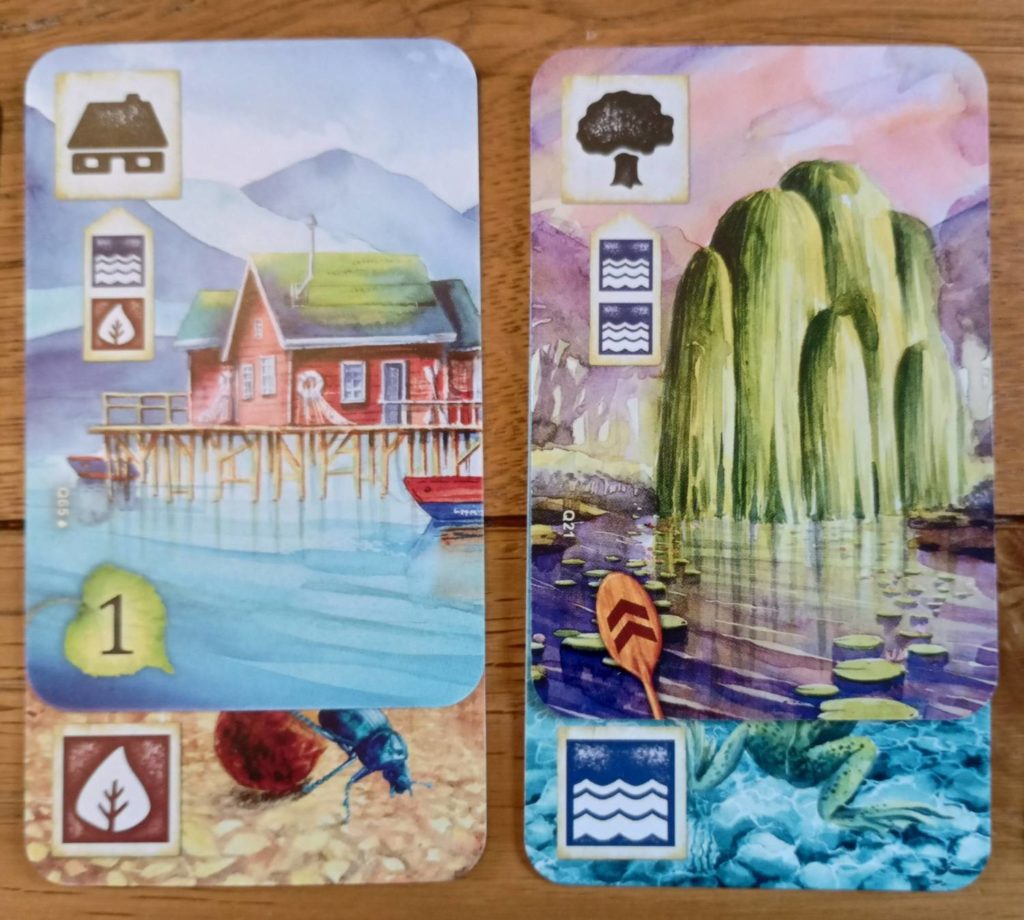
It’s not a separate thing at all, just an additional selection of cards that might be able to help you achieve your goals, another set of threads in the web. Through the mechanisms powering Downstream, designer Klemens Kalicki has yet again demonstrated the interconnectedness of the natural world and how river habitats are inextricably linked to the terrestrial environments around them.
Hidden Depths
What I’ve come to realise though is that there’s something else that Downstream adds to a game of Meadow, beyond simply some nice rewards and beautifully illustrated aquatic cards (and once again a standing ovation for illustrator Karolina Kijak who has done an outstanding job).
It all has to do with timing.
Here’s the thing: Regardless of which side of the river board you use, the river’s current flows past a whole bunch of bonus actions. They’re rather like the special campfire actions you can take in the base game, only there are more of them and some are more powerful. A lot of them are particularly good if you land on them once you’ve got things set up just right.
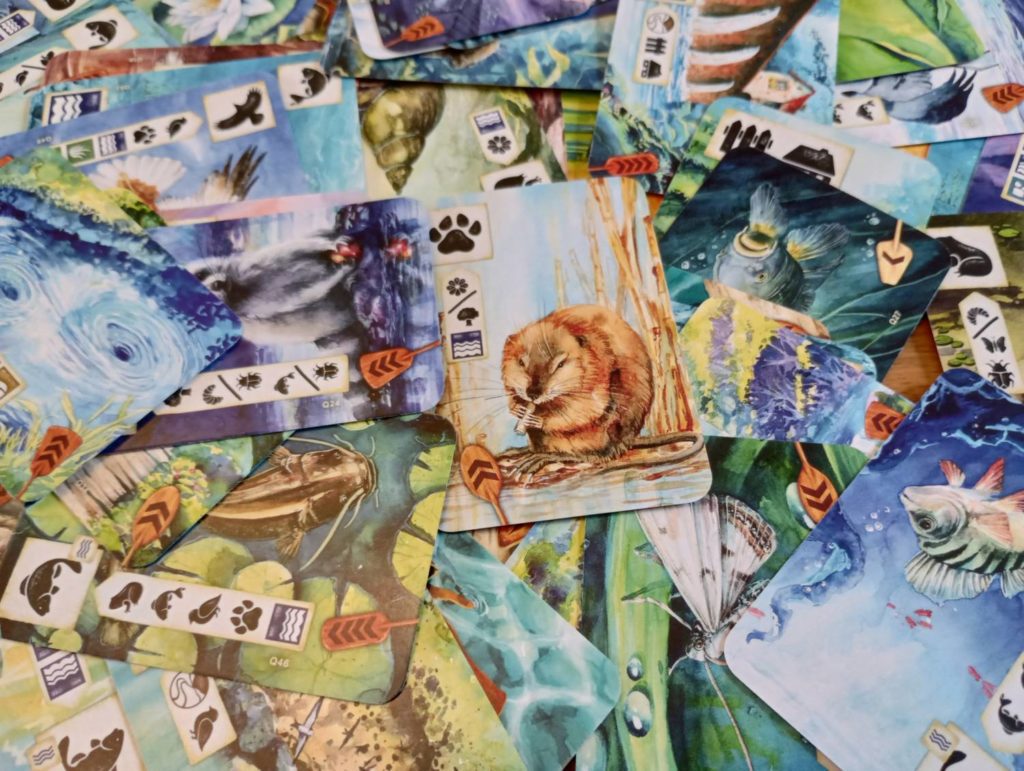
Planning in the base game involves fairly linear sequences: I pick up A and place it, place B on my next turn, and then A and B give me the right symbols for C, meaning that the turn after that I can place D.
Planning with Downstream adds a layer of timing. Those chains are still there, but you might start by placing E to shunt your kayak along so that when you place A you also get a bonus that sets up F and G, as well as the B-D in later turns.
Confused?
Here’s an example: On the ‘lazy river’ side of the new board is a space where if you have a pair of symbols visible in your meadow as you pass you can score a few additional points. But timing it so that you pass that space in the river with those specific symbols showing is tricky. Get them too late and you’ve already floated past. Get them too early and you’ll spend turns trying to preserve them, hamstringing yourself to keep them visible to fulfil that goal. You want to time it perfectly.
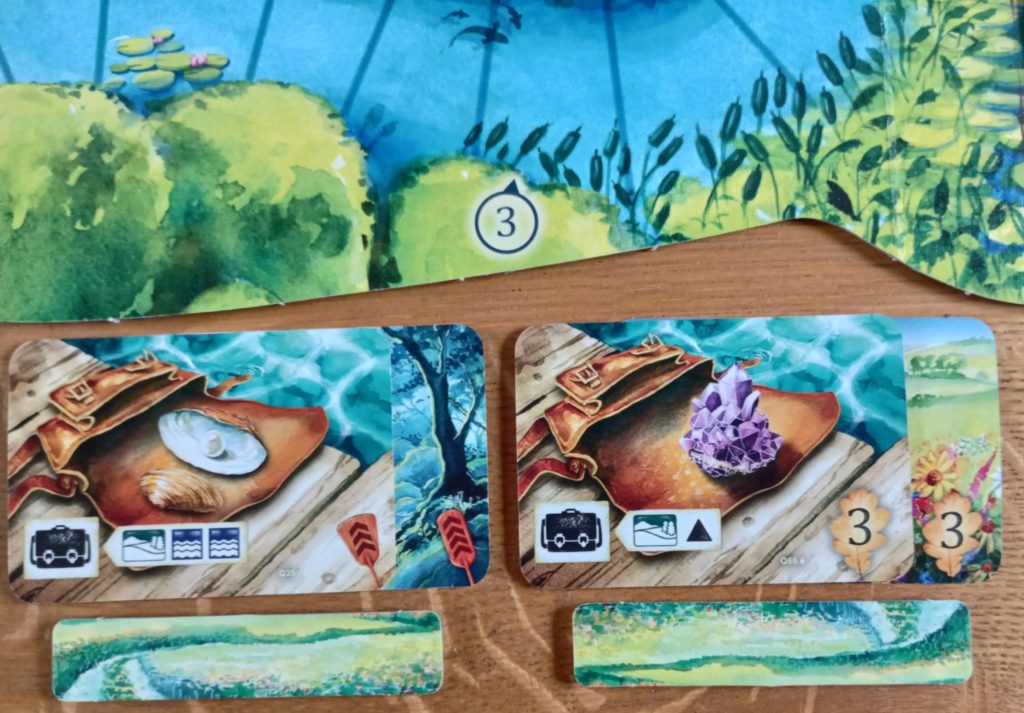
There’s nothing like that in the base game and it’s a fascinating wrinkle to the decision space. The other river bonuses aren’t as symbol-dependent, but the timing of when you trigger many of them can make a huge difference. Even the simple bonus of being able to play a card to your meadow adds another dimension to your planning. Timing your river bonuses to take best advantage of them is deeply satisfying.
“Let your boat of life be light, packed with only what you need” Jerome K. Jerome
The big question then: Is Downstream a good expansion?
The simple answer is yes… but.
The more nuanced answer is that it depends on what you’re looking for. Meadow isn’t a complicated game, but it already had the power to tie your brain up in surprisingly tangled knots as you plotted the paths of multiple cards from market to hand to meadow. The addition of Downstream snarls those thought-threads further.

You’ll be doing a whole load of staring at those markets and cross-checking them against each other, the cards in your hand, the cards in your meadow and the symbols spotting everything. Add in checking the river path with its bonuses and the oar symbols on the river cards which push your boat along and what seems straightforward starts glueing up your decisiveness.
Meadow with Downstream becomes slower and quieter, the gaps between turns stretched a smidge further. Not to mention, with the added action token, everyone now has an extra turn each round so the game’s overall length is longer even without the added thinking time. I’ve always preferred Meadow at lower player counts and that’s doubly so now.

It’s also a bit of a table hog, the central boards spreading like pennywort. For a game that’s essentially just players creating card tableaus in front of them, it’s surprising just how much surface real estate Meadow with Downstream requires.
You won’t be complaining about how it all looks set up though. Downstream lives up to the beauty of the original. Both sides of the river board are simply lovely. The ‘wild river’ side is probably more interesting than the ‘lazy river’ side overall, with its heavier focus on racing to get the best bonuses and various alternative pathways and shortcuts. But neither side is a duffer and I like that there’s an option for when you’d like to include the river but limit the sheer number of things to consider.
The reward for a slower and larger game is a knottier puzzle and an extra layer of contemplation and problem-solving. The additional 6 cards in the river market makes the game slightly less susceptible to the occasional unlucky shuffle of the deck and gives the players more room to manoeuvre. And now, as well as gazing at your beautiful meadow, at the end of the game you can admire how far your kayaker has travelled. It feels like you’ve achieved more without diluting the purity of that achievement.
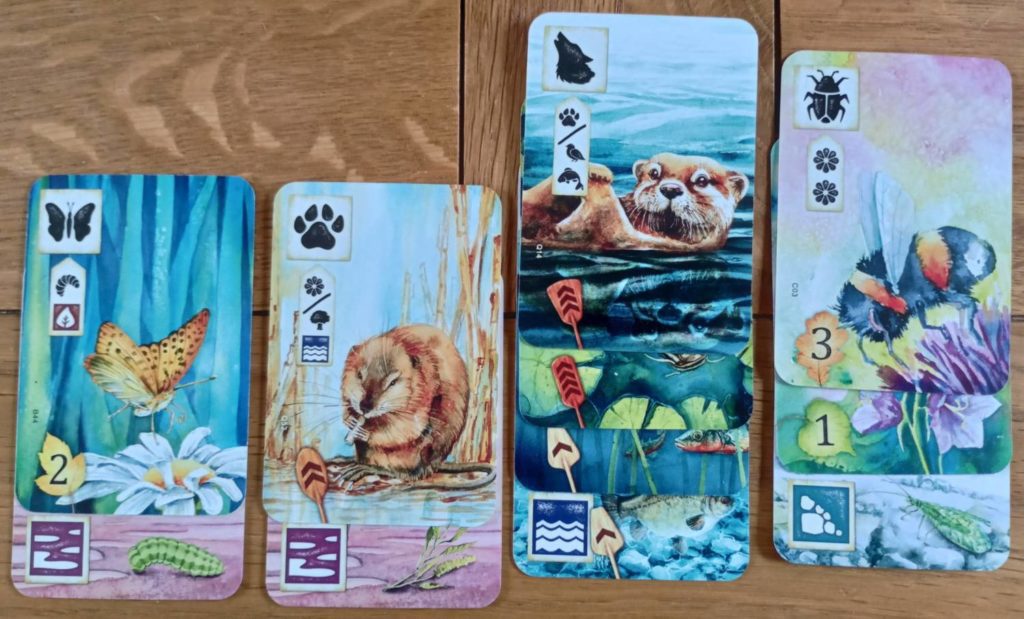
Tonally, Downstream is also a wonderful addition. On a nature walk you can often just immerse yourself in your surroundings. Kayaking, even down a lazy river, requires a little more focus and effort. Like its real-life equivalent, Downstream asks for a little more attention, a deeper consideration of the mechanics behind your movement than in the base game. Intended or not, it’s a lovely example of game reflecting life.
In summary then, Meadow: Downstream is well worth a paddle, adding depth and beauty to an already wonderful game. But with the additional time and effort involved I’m not sure I want to get the boat out every time I’m looking to enjoy the nature-based experience that Meadow offers. Sometimes I’m too lazy, even for a lazy river.


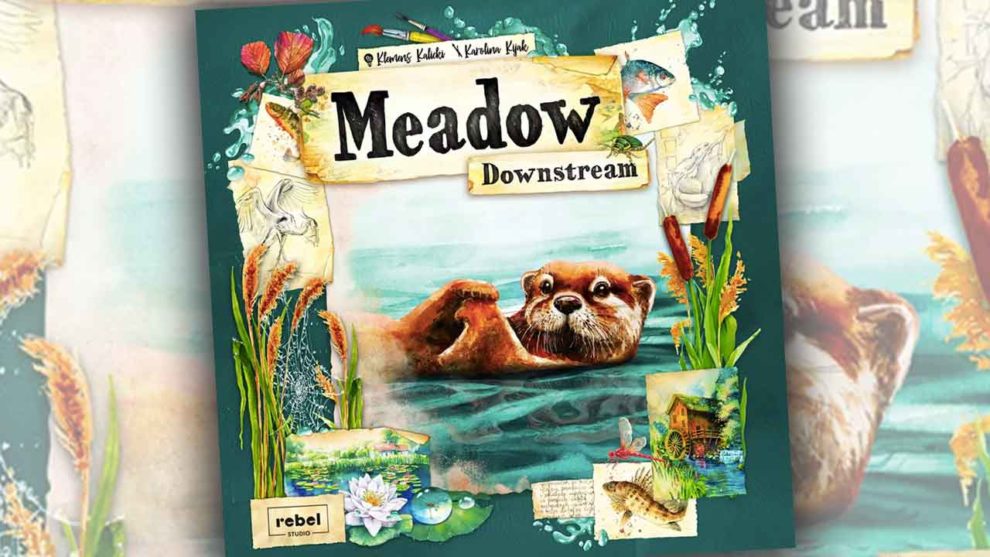









Add Comment